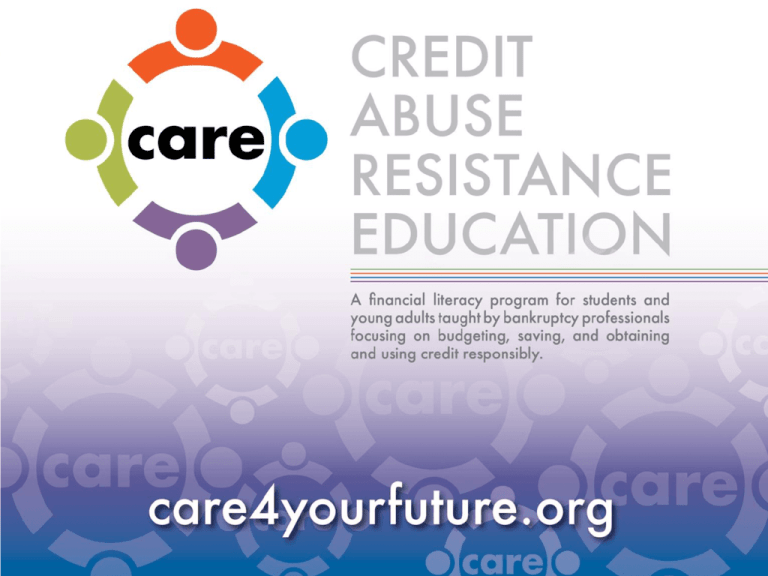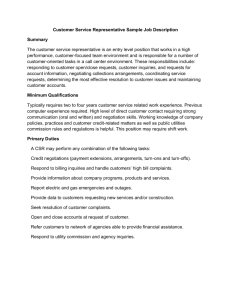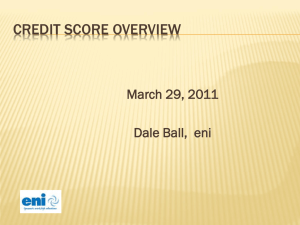What is in a credit report?
advertisement

Your parents can’t fix everything
How to rescue your credit
—before it needs saving!
Your credit history
Begins when you choose
and use credit services
• Influences your ability to obtain products and
services—and how much they’ll cost you
• Credit cards
• Car loans/leases
• Private student loans
• Mortgages, leases
• Employment
Your credit history matters!
A good credit history will help you access
services to improve your quality of life
A bad credit history will hold you back–and
your missteps will follow you for as long as
10 years
How it works
Three credit reporting companies update and distribute
consumers’ information: Equifax, Experian and TransUnion
Consumer applies
for credit
Creditor requests
information about
consumer’s financial
history
Credit profile used to
determine whether to
authorize credit—and if
so, at what interest rates
Consumer is granted (or
denied) credit
Credit grantor reports
activities back to credit
reporting companies
every 30 days
Credit reporting
companies update
consumer’s information
What is a credit report?
2
Lists the type of
credit a consumer
uses, the length of
time the accounts
have been open,
and whether the
consumer has
paid their bills on
time
1
Summary of a
consumer’s
financial
reliability
4
Prepared by
credit reporting
companies for use
by credit grantors
and other parties
with permissible
purpose
3
Details a
consumer’s credit
history as it has
been reported
Tells lenders
how much
credit a
consumer has
used and
whether they
are seeking new
sources
5
Types of credit reports
Consumer disclosure
(Consumer version)
1. Lists all inquiries including limited
inquiries and account reviews
2. Only consumers can request this
version
Subscriber report
(Credit grantor version)
1. Abbreviated version of consumer
credit report that creditors see
2. Does NOT contain limited inquiries
or account reviews
3. Contains credit inquires
Elements of a credit report
What is in a credit report?
What is NOT in a credit report?
Identifying information
Race
Credit history
Gender
Inquiries
Religion
Sexual orientation
National origin
Medical history
Checking or savings account balances
Income
Driving record
Report card
How can you get a copy
of your credit report?
• You get one free report every 12 months from each of
the three bureaus!
• Visit AnnualCreditReport.com to download
• You can also get free reports at CreditKarma.com
What is a credit score?
Sum calculated by vendor and used by lenders as an
indicator of how likely consumer is to repay loans
Snapshot in time of the consumer’s current financial
situation
Generated by a mathematical formula
Each credit grantor has its own strategy for
interpreting the credit score
If credit is denied after reviewing the score, credit
grantors must disclose reasons for the decision
What’s in a credit score?
What’s calculated in a credit score?
Payment history
Outstanding debt
Credit account history
Recent inquiries
Types of credit used
What is NOT calculated in a credit score?
Demographic information
Age, race, religion, national origin,
gender, sexual orientation, marital
status, residence, child/family support
obligations
Employment information
Salary, occupation, title
Other credit information
Interest rates charged by other credit
grantors, usage of a credit counseling
company
What are the Five Parts that go into a
Typical Score? What Percent for each part?
Payment history: 35%
- Account payment information
- Adverse public records
- Amount of delinquent
accounts
- Number of past due
items
New credit: 10%
- # of recently opened
accounts
- # of recent inquiries
Credit history length: 15%
- Time since accounts opened
Accounts owed: 30%
Types of credit used: 10%
- # of various types of accounts
- Outstanding balances on accounts
- Proportions of balances to total credit
limits
- Proportion of installment loan
amounts
What’s a good credit score?
300
400
500
Typically the higher the score the
better
600
700
800
900
You are here
Individual credit grantors decide range
of acceptability
For example, a consumer’s credit
score might be 680
Based on this particular model, here is
how the consumer may be viewed by a
certain lender
Very
poor
Poor
Fair
Good
Very
good
You are here
Credit management tips
The single most important component of your credit score is
whether you make payments on time
• Your parents can make a payment for you.
• Your parents cannot make a late payment
not late.
A late payment stays on your credit history and
impacts your credit score for as long as 7 years.
However, the impact lessens as time passes.
More credit management tips
Set goals
Clean up your records
•
Check your credit report every three
months
•
Dispute negative inaccuracies on
your credit report
•
Improve your credit score 50 points
or to above 650
•
Remove expired debts and collection
accounts
•
Reduce your debt balances to below
35% of available credit limit
•
Consider refinancing
•
Guard against identity theft
•
Create a budget and stick to it
Top 5 misconceptions
1
2
3
Your credit
score will drop
if you check
your credit
report
Closing old
accounts will
improve your
credit score
Once you pay
off a negative
record, it is
removed from
your credit
report
4
5
Being a coPaying off a
signer doesn’t debt will add 50
make you
points to your
responsible for
credit score
the account
If you find a mistake…
First, correctly
identify
inaccurate
information
Next, contact
the credit
grantor
responsible for
the inaccuracy
and try to
resolve the issue
If this does not
work, contact
the credit
reporting
company(s)
reporting the
inaccurate
information
Credit reporting
company(s) will
investigate the
issue
At the
conclusion
of the
investigation, or
within 30 days,
you’ll be
contacted
You have the right to dispute inaccurate
information on your credit report
What questions do you have?
●{
Stay Connected!
Like us! www.facebook.com/careforyourfuture
Follow us! @care4yourfuture
Connect to us on LinkedIn!
Visit!
www.care4yourfuture.org
www.CAREChicago.org





